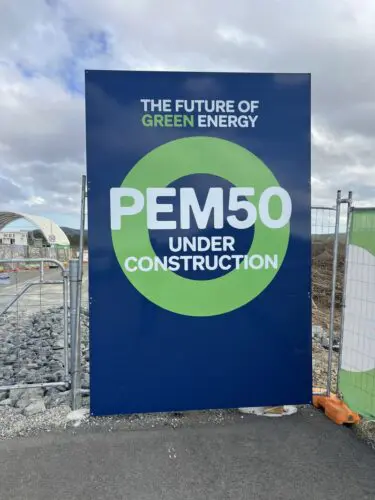Fortescue breaks ground on Gladstone PEM50 green hydrogen facility

The Gladstone electrolyser factory. Photo: Fortescue.
Rachel Williamson
Sep 12, 2024
5
Share via Email
Hydrogen
Iron ore and green energy company Fortescue has broken ground on its $150 million PEM50 green hydrogen project in Gladstone, Queensland.
The two-stage 50 megawatt (MW) project reached financial close at the start of this year and is planned to start producing hydrogen in 2025.
The first stage is a 30MW electrolyser plant and the second will see the installation of another 20MW of capacity depending on upgrades to water supply infrastructure to the site, but anticipated to see commissioning in 2028.

The Gladstone site. Image: Fortescue green hydrogen technical sales manager Lucy Dyer
The PEM stands for proton exchange membrane technology and in April, Fortescue opened the 15,000sqm Gladstone manufacturing base that will produce about 2 gigawatts (GW) of the electrolysers each year.
But Fortescue also walked back ambitions to produce 15 million tonnes of green hydrogen annually by 2030 in July and deprioritised four hydrogen projects in the face of high electricity costs and few buyers.
The company confirmed in April that the the Gibson Island facility near Brisbane, where Fortescue hoped to build a 550 MW capacity electrolyser facility to make green ammonia, had been held back by concerns about power prices.
And yet even in 2022, when Fortescue revealed the scale of what would be needed to meet that target, it admitted that was a “stretch goal”.
Andrew Forrest’s Fortescue Future Industries has revealed some of the extraordinary numbers behind its hugely ambitious goal to deliver 15 million tonnes of green hydrogen production a year by 2030.
To achieve 15 million tonnes of green hydrogen output a year in 2030 would require 150GW of hydrogen electrolysers and a phenomenal 450GW of renewable capacity, or at the time around nine times the current capacity of large scale generation in Australia’s National Electricity Market. Global electrolyser production was around 1GW at the time.
“The green hydrogen market, globally, is still developing and, currently, the cost of power in many countries is too high,” CEO Mark Hutchinson said during the company’s earnings call in August.
“What we won’t do is give up when power costs are prohibitive, we’ll work to bring those costs down longer term. We totally believe that green hydrogen is what the world ultimately needs, and that’s why we continue to maintain a significant portfolio of potential projects.”
Fortescue is also leaning into an electrolyser market that is both full of opportunity and teetering on a dangerous edge.
Electrolyser buyers are enduring long waits for equipment, according to a report in the AFR newspaper in July.
But the global industry for electrolyser makers is challenging as companies struggle to meet overblown valuations and expectations set in 2021-22, and are labouring under high levels of debt and too few sales, as Renew Economy reported this year.
Fortescue has been contacted for comment.
Share on Twitter Share on Facebook Share on Pinterest Share on LinkedIn Share on Reddit
reneweconomy.com.au |






